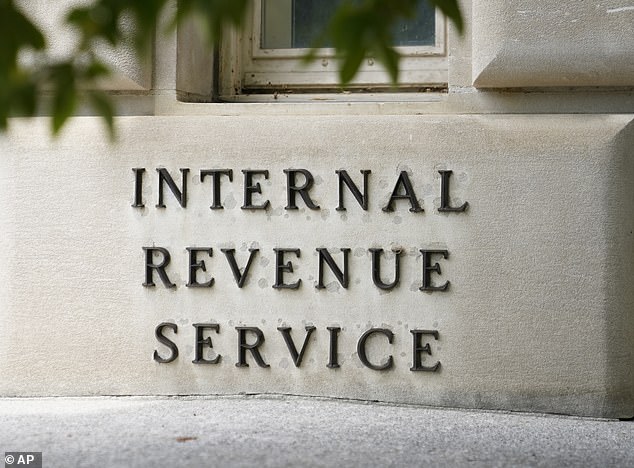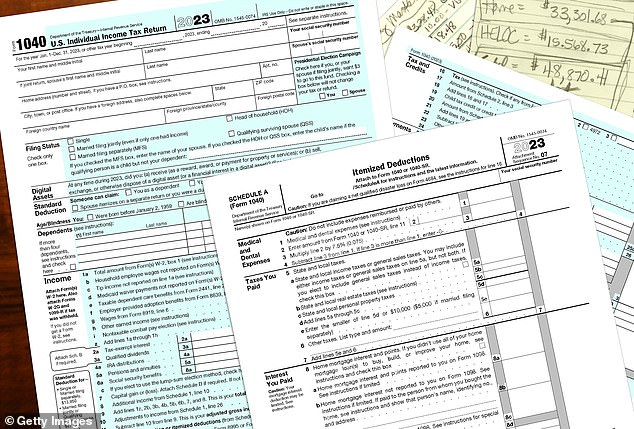Tax returns scare you? Here's what you need to know ahead of tax season
Tax season is quickly approaching, which means millions of Americans will start thinking about filing a 2023 return.
For many people, tax season can be daunting, bringing questions about deadlines and deductions.
Taxpayers may be wondering how early – or late – they can file a return this year, and whether any changes have been made to income tax brackets.
Since last year's tax season, the Internal Revenue Service (IRS) has made some changes to credits and deductions, so it's important to be aware of these so you know what you may qualify for.
Here we answer the most pressing questions as tax season approaches.

For many people, tax season can be daunting, bringing questions about deadlines and deductions
When is the tax deadline this year?
Tax day is April 15. It is the same date every year unless it falls on a weekend or holiday.
This year the date falls on a Monday.
When is the earliest I can file my 2023 taxes?
Typically, taxpayers can start filing in late January. Last year, the IRS started accepting returns from January 23.
A date for people to file 2023 returns has yet to be set, but it is expected to be around January 23 or 24.
Some experts suggest Americans should wait to file taxes until closer to the deadline — because they could take advantage of some last-minute tax breaks being negotiated in Congress.
What are the new tax brackets for income tax?
Income tax brackets rose 7 percent for 2023, reflecting 40-year high inflation rates the year before.
Income tax in the US is progressive, meaning the more you earn, the more you end up paying as a percentage of your income.
These are the tax brackets for the 2023 tax year:
For individual submitters:
- 37 percent for incomes above $578,125
- 35 percent for incomes above $231,250
- 32 percent for incomes above $182,100
- 24 percent for incomes above $95,375
- 22 percent for incomes above $44,725
- 12 percent for incomes above $11,000
- 10 percent for income less than $11,000
For married couples, filing jointly:
- 37 percent for incomes above $693,750
- 35 percent for incomes above $462,500
- 32 percent for incomes above $364,200
- 24 percent for incomes above $190,750
- 22 percent for incomes above $89,450
- 12 percent for incomes above $22,000
- 10 percent for incomes under $22,000
The income tax brackets will increase again for the 2024 tax year.


The IRS increased income tax brackets by 7 percent for 2023, reflecting 40-year high inflation rates the year before
What is the new standard deduction this year?
The standard deduction for the 2023 tax year also increased by about 7 percent. It is $13,850 for single filers and $27,700 for married, joint filers.
Taxpayers claim the standard deduction to reduce their income by a predetermined amount.
Some taxpayers choose to itemize their deductions if the total is greater than the standard deduction.
What is the additional standard deduction for people over 65?
In the 2023 tax year, Americans who are over 65 or blind will have certain requirements criteria as described by the IRS are now eligible for an additional standard deduction.
The additional standard deduction is $1,850 for single filers or those filing as head of household, and $3,000 for married couples filing jointly if each spouse is over age 65. This increases the total amount to $15,700 for single filers and $30,700 for married couples.
Are there any changes to the itemized deductions for the 2023 tax year?
Itemized deductions 'remain largely the same' for the 2023 tax year, according to Charles Schwab, quoted by USA today.
The financial services provider points out that these itemized deductions remain the same:
- State and Local Taxes: The deduction for state and local income taxes, property taxes, and property taxes is limited to $10,000.
- Mortgage interest deduction: Americans can generally deduct interest on the first $750,000 of mortgage debt. But those who purchased a home before December 16, 2017, can deduct interest on the first $1 million.
- Medical costs: Only medical costs that exceed 7.5 percent of the adjusted gross income are deductible in 2023.
- Charitable Donations: In 2023, the annual income tax deduction limits for donations to public charities will be 30 percent of adjusted gross income for contributions of non-cash assets – if held for more than one year – and 60 percent of adjusted gross income for cash contributions.
Am I eligible for free tax filing with the IRS?
Certain taxpayers in specific states can file and file their taxes directly with the IRS this year through the Instant file pilot project.
The pilot is currently open to eligible taxpayers in twelve states: Arizona, California, Florida, Massachusetts, Nevada, New Hampshire, New York, South Dakota, Tennessee, Texas, Washington and Wyoming.
The agency said qualified Americans must also report certain types of income, credits and deductions.
“Initially the Direct File pilot will only be open to a small group of taxpayers, later in the filing season we will open the Direct File pilot to more people to file their 2023 tax returns,” the IRS website said .


Tax day is April 15. It is the same date every year unless it falls on a weekend or holiday
What are the IRA and 401(K) contribution limits?
Employees enrolled in a company pension plan could contribute $22,500 to their 401(K) in tax year 2023, and employees with an individual retirement account could contribute up to $6,500.
People age 50 and older have higher limits — and the limits will increase to $23,000 and $7,000 for the 2024 tax year.
What is the income limit for child tax credits?
The child tax credit pays up to $2,000 for each qualifying child under age 17. Up to $1,600 of the payout is refundable for 2023 taxes.
About 14 states also offer their own child tax credits, according to the National Conference of State Legislatures.
The credit decreases if your modified adjusted gross income exceeds $200,000, or $400,000 for a married couple filing jointly.
A bipartisan group of lawmakers is reportedly working to expand the child tax credit before it's time to file tax returns this season, according to Business insider.
How can I estimate my tax refund and how quickly can I expect a refund?
Tax returns for companies Turbo tax And H&R block provide tax refund estimators, as do nonprofits AARP.
According to the IRS, most refunds will be issued within 21 calendar days. Paper check returns may take longer: four weeks or more.
